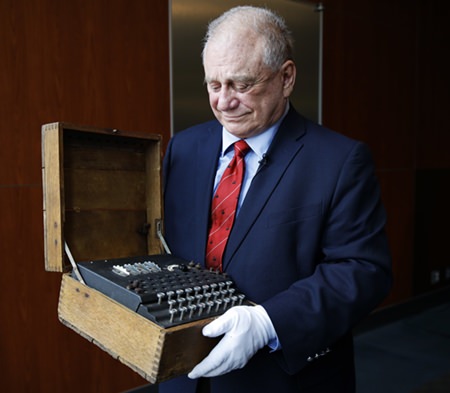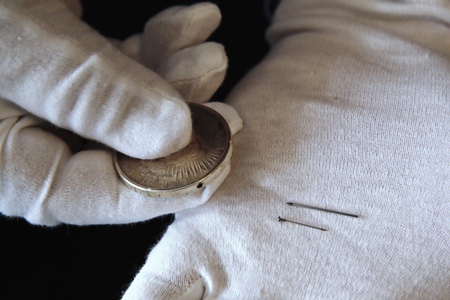
Washington (AP) — H. Keith Melton spent 40 years looking for the ice-climbing ax used in the bloody assassination of Russian revolutionary Leon Trotsky. It had been sitting under a bed in Mexico City for decades.
Much easier was acquiring a mangled, basketball-size chunk of Gary Powers’ U2 spy plane shot down over the Soviet Union in 1960. It was a gift from a Soviet official.
The items are part of the world’s largest private collection of spy artifacts. Melton, a wealthy businessman from Boca Raton, Florida, is donating all of it to the International Spy Museum in Washington.
More than 5,000 items Melton amassed during four decades of crisscrossing the globe will be the cornerstone of a new, larger facility slated to open next year in the U.S. capital.

It is a “magnificent gesture,” gushed Peter Earnest, the museum’s founding director, crediting Melton’s donation with tripling the museum’s current holdings of roughly 2,000 items.
There’s a victory flag that CIA-backed Cuban exiles never flew after the botched Bay of Pigs invasion in 1960.
There’s a 13-foot-long World War II spy submarine known as the “Sleeping Beauty.”
And there are escape-and-evasion devices, codes and cipher machines along with the disguises, secret writings, listening devices, clandestine radios, spy cameras and uniforms and clothes of the most famous spooks every employed by CIA, KGB, FBI and Britain’s MI6.
“It took nine people 17 days to pack the collection in an assembly line,” Melton told The Associated Press in an interview this month. “I had to breathe deeply several times as I saw all of the gadgets being packed up and leaving.”
Melton, a founding member of the museum’s board, said professional appraisers estimated his collection at more than $20 million. He said he’s paid “foolish” prices for some items and, at times, acquired things that he later learned were fakes.
“To me, the goal is not to see how many widgets I can get. It’s what can I learn. I love research. Every artifact I have is part of a detective search,” he said. “You travel into strange places in the world and sometimes pay too much money, but you end up fascinated with the variety of things that you see.”
Melton placed ads around the world seeking spy articles. He was in Germany in 1989 after the Berlin Wall came down and traveled to Moscow in early 1992 after the Soviet Union collapsed. In both instances, he made contacts that helped him find items from the defunct East German ministry for state security and the Soviet KGB.
Among them: a World War II-era electro-mechanical cipher machine with Japanese characters that the Germans produced to share with their Asian ally. The war ended before the Enigma machine, which looks like a special typewriter in a wooden box, could be sent to Japan. A U.S. soldier found a stack of the machines in a boat in France and took one home with him to Long Island, New York.
“He kept it in his closet for 50 years,” Melton said.
Another item is a silver dollar concealing what appeared to be a tiny straight pin. It was one of five suicide needles filled with shellfish toxin that U.S. intelligence services made around the 1960s so American spies could kill themselves on an operation gone awry.
Melton’s biggest coup — the item he looked for the longest — is the ice ax that killed Trotsky at his compound outside Mexico City in 1940. The assassin was Ramon Mercader, a communist and suspected agent of Soviet leader Joseph Stalin who was jailed for years in Mexico.
A man who operated a teaching museum within the Mexican police checked out the ax from a police property room in the 1940s. He then got it in the 1960s as a retirement present.
“He gave it to his daughter and it had been under her bed until 2008,” Melton said. “She pulled it out. I made three trips to Mexico City and we were able to prove that it was the right ax.”




